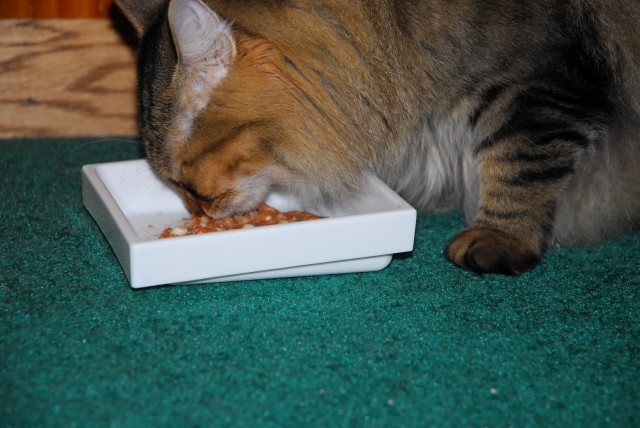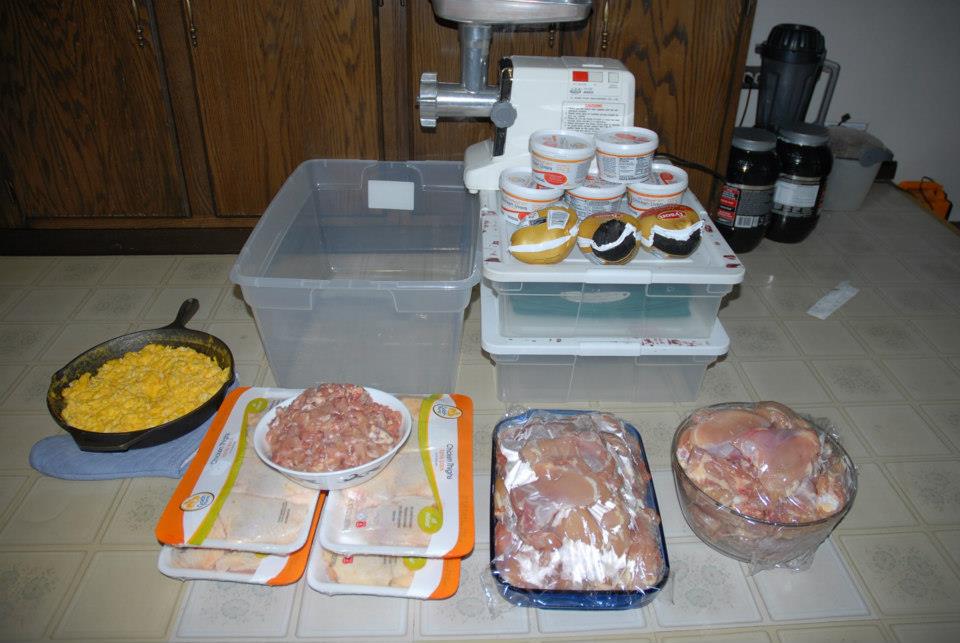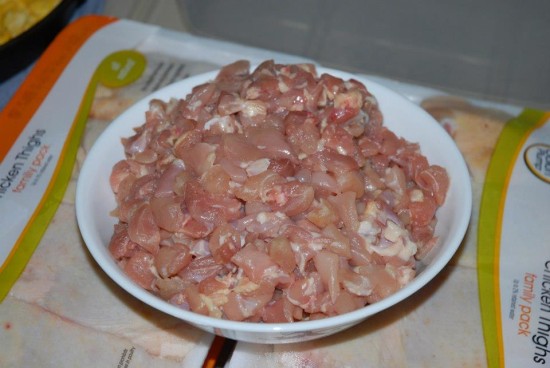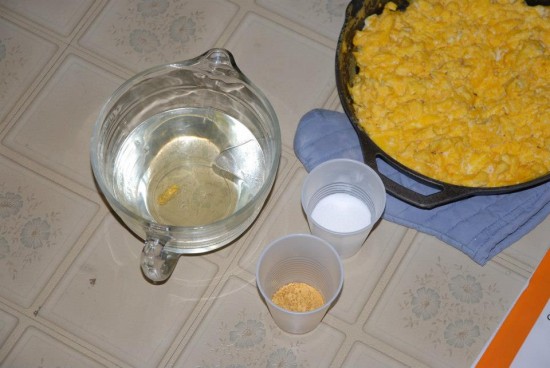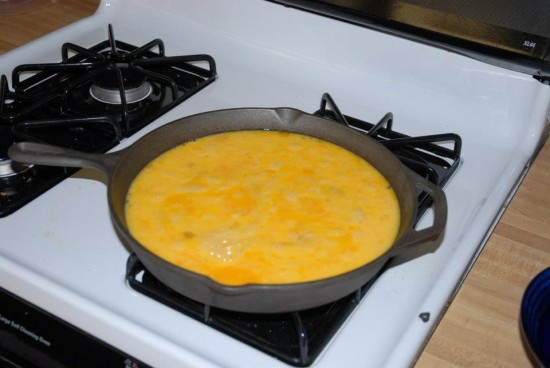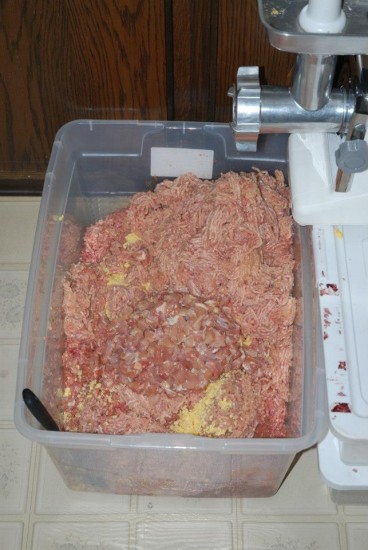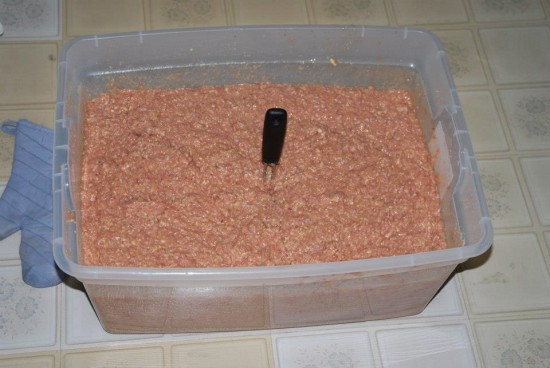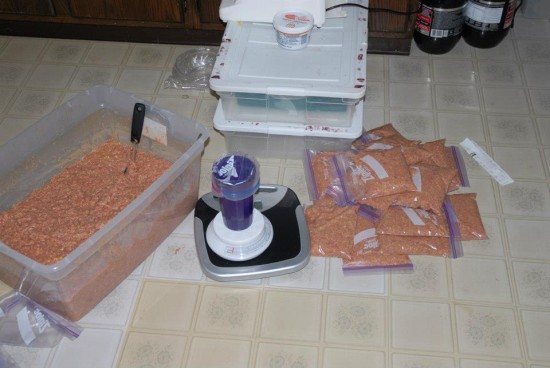Have you ever wanted to make your own cat food, but didn’t know how? My husband and I have been feeding our cats a raw food diet for a little over three years now. In our three years of doing this, there’s a lot that we’ve learned about how to make the food, and how to make that process easier. Here’s how we make our raw cat food.
First, a note. The raw cat food recipe we use isn’t one we developed. We found it here, on Dr. Lisa Pierson’s website, Catinfo.org. This site a fantastic resource not only for making the food itself, but also for why these diets are the best for cats. It explains why commercial cat food isn’t healthy for our cats, and why raw food is considered “species appropriate.” It also explains the ins and outs of making raw cat food. We have modified the recipe slightly based on what we can afford and what’s practical for how much food we make.
Supplies you’ll need
Meat grinder labeled for grinding both meat and bone
Large measuring cup
Meat cutting scissors
Mixing bowls and regular bowls
Mixing spoon
Kitchen scale capable of measuring fractions of ounces
Safety pin (optional)
Mortar and pestle (optional)
Ingredients
3 pounds chicken thighs with bone and skin (must be free of hormones and antibiotics, does not need to be organic, though that is best)
4 oz chicken livers
400 IU vitamin E
50 IU vitamin B-complex
2000 mg taurine
5000 mg fish oil
1 tsp iodized salt (must be iodized)
2 eggs (scrambled)
1 cup water
A note about the supplements for raw cat food
We prefer to use the Source Naturals brand of supplements, which is available at Amazon. This is especially important for the B-complex, because the Source Naturals vitamins don’t contain the same amounts of vegetable cellulose that store-bought vitamins do.
We found out the hard way that our cats’ digestive systems are very sensitive to vegetable cellulose when we subbed store-bought B-complex for the Source Naturals B-complex, because we ran out. Even though our cats were only getting tiny amounts of the store-bought vitamins, all four ended up with nasty cases of gastritis. One had to be hospitalized. Thankfully, they’re all fine now. This is why we get the Source Naturals supplements.
This B-complex also doesn’t have any vitamin C in it, which is good.
One more note: It’s best to order fish oil capsules because they’ll stay good for much longer than just a bottle of fish oil, and make sure it’s not cod liver oil. According to Dr. Pierson, cod liver oil is not good for cats.
Processing the meat
The first thing we do when we make raw cat food is process the chicken. Dr. Pierson says that removing bone from roughly 25 percent of the meat will create the proper balance between the calcium of the bone, and the phosphorus in the meat, for your cat.
She also recommends removing the skin from 40 percent to 70 percent of the meat so that your cat is getting the fat content that she needs, but isn’t getting too much.
We prefer to remove the largest fat deposits from the chicken thighs, too. This is because we have two cats that need to be on low-fat diets, due to health problems that a higher fat content makes worse.
Don’t try to trim all the fat off the thighs, however, because then you’ll remove too much fat and your cat will lose too much weight too quickly, which can make her very sick. There are usually two big fat deposits on the sides of the thighs that are visible and easy to trim off. That’s all you need to trim.
However, if your cat doesn’t need to lose weight or otherwise avoid higher amounts of fat, then don’t remove those two deposits either. Just remove the skin.
At this point, you can bake each piece of chicken in the oven to kill surface bacteria. We don’t do this, however, it’s a wise idea if you’re getting your meat from the grocery store. Dr. Pierson cooks her poultry thighs until they’re about 10 percent to 20 percent cooked. You can do that, or just cook them for a minute or so.
Avoid cooking them any more than 20 percent, because doing so will destroy necessary nutrients and make the bones so brittle they’ll shatter in the grinder. That will make the food very unsafe for your cat to eat.
Put each finished piece of chicken into a mixing bowl. Once that’s done, cut up one de-boned, trimmed thigh per 3 pounds of meat into small, bite-sized chunks, so your cat has something in her food to chew. Put these into a separate bowl, because you don’t want to put them through the grinder. Cover the bowls, and put them into the fridge to chill while you’re working on other parts of this process.
Mixing the supplements
My husband and I work together on making the food, because we make so much at one time. So while he’s processing the chicken, I’m mixing the supplements. The first thing I do is count out all the pills I need, and put them into separate cups so I don’t have to count while I’m working. I also make sure I have some of the water we need for the food ready so that I can mix the supplements in as I go along.
After I gather everything together and count it out, I measure the salt and pour it in the water. Then I use a mortar and pestle to crush the vitamin B-complex into powder. When that’s done, I stir the powder into the water as well as I can. The B-complex doesn’t mix very well, so just do the best you can with that. I also pull apart the taurine capsules and shake the powder into the water, too, and stir occasionally.
Once those three parts are finished, I use a safety pin to poke holes in the vitamin E and fish oil capsules, and then I squeeze the oil out onto the water.
Oil sits on top of water, which is why you want the powders done first. If you do the oils first, then mixing the powders into the water will be far harder than it needs to be.
The gelatin in the shells for the fish oil and vitamin E won’t hurt your cats any, but they take forever to dissolve in water. The same is true with the vitamin B pills, and the taurine shells. You can do it that way, but you’ll be waiting a long time for everything to dissolve. It’s more work to do it my way, but it’s also easier in the long run.
When you finish with this step, set the mixture aside. It doesn’t need to be refrigerated.
Now you need eggs for your raw cat food
Take your eggs, scramble them, and cook them lightly. We find this to be easier than separating the yolks from the whites, and then only cooking the whites while leaving the yolks raw, as Dr. Pierson recommends. We do that because we tend to make 120 pounds of food at one time, and that is a lot of eggs to separate. So we scramble them and cook them. When they’re done, set them aside. It’s time to start grinding the meat.
Putting your raw cat food together
Set your biggest mixing bowl under your grinder, and then start grinding the chicken up. The order you use doesn’t matter, but we prefer to do the intact thighs first, then the trimmed thighs that still have bone in them, and then the rest of the thighs. Then we put the eggs through the grinder, and finally, the liver. The reason I prefer this order is because the livers come with a lot of juice that can help “rinse” out your grinder.
That, in turn, leaves less meat and bone in your grinder, making cleanup easier.
Now you have an odd-looking, segmented, layered mixture. Pour the water and the supplements in carefully, and then add more water as you see fit. Use your mixing spoon to mix it all together very thoroughly. Make sure the mixture is uniform all the way through. Once it’s all mixed, that’s your raw cat food.
At this point, because you’ll have to transition your cat from her normal food onto her raw cat food slowly, I suggest that you first divide it into half-pound portions and store them in quart-sized Ziploc baggies in your freezer except for the bag you’re currently using. If you only processed three pounds of meat, this should give you about six or seven baggies’ worth of food. You might end up with a little more or a little less.
One more thing that might make it easier for you if you’re making a whole lot of food, too: We’ve recently started de-boning and trimming the chicken as soon as we buy it. This way, food-making day takes a lot less time, and all those pieces of chicken take up less space in our freezer. If you think you’ll eventually make a lot of food like we do, this could work for you, too.
Recommended Links
Feline Nutrition Foundation
Dr. Lisa Pierson
If this method isn’t for you, but you want to put your cat on a healthier diet, try looking for foods that have as few plant products as possible. The biggest problem with many commercial cat foods is that they contain too many plant products, which cats can’t digest. You can look at the ingredients lists, or check for fresh food diets at your local supermarket.

